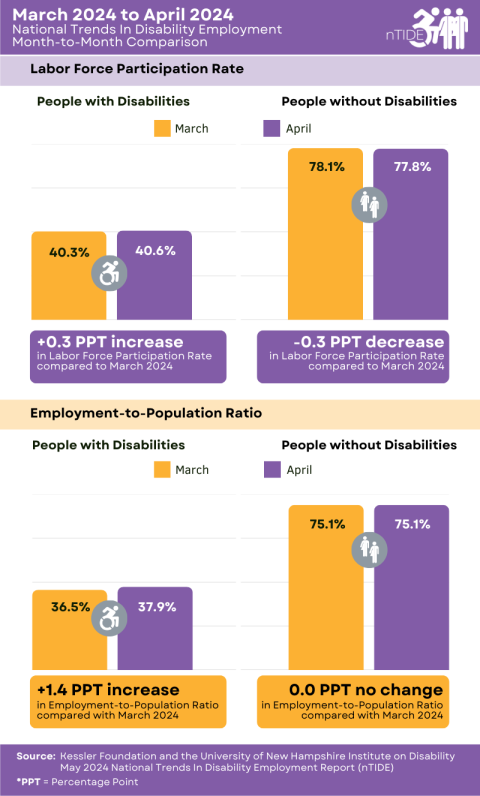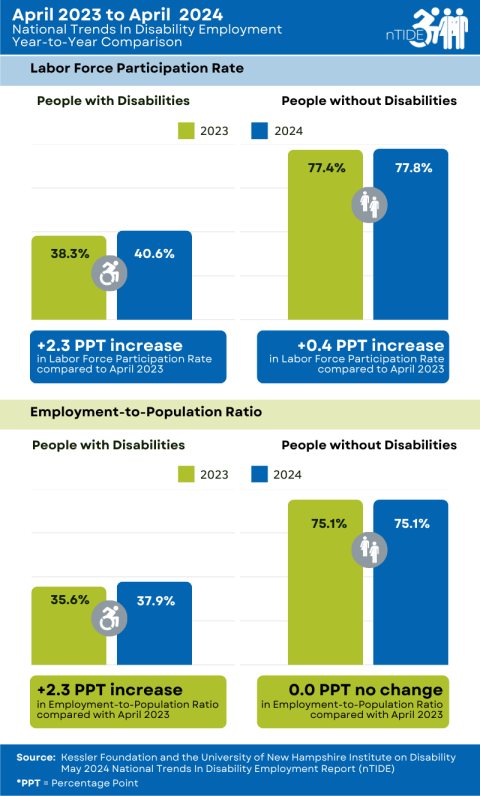
Join us for the next nTIDE Lunch & Learn Webinar featuring guest presenter Adene Karhan from the Center for Advancing Policy on Employment for Youth (CAPE-Youth).
nTIDE April 2024 Jobs Report: Post-Pandemic Gains Seen in Employment for People with Disabilities Appear to Continue
National Trends in Disability Employment (nTIDE) – Issued semi-monthly by Kessler Foundation and the University of New Hampshire
May 3, 2024 – Following a two-month decline, the employment of individuals with disabilities returns to near historic highs reported by nTIDE in late 2023, reaffirming the significance of those prior highs. That’s according to today’s National Trends in Disability Employment – semi-monthly update (nTIDE), issued by Kessler Foundation and the University of New Hampshire’s Institute on Disability (UNH-IOD).
Month-to-Month nTIDE Numbers

This graphic compares the labor market indicators for March 2024 and April 2024, showing a slight increase in the labor force participation rate and the employment-to-population ratio for people with disabilities. The employment-to-population ratio remained flat and the labor force participation rate dropped slightly for people without disabilities.
“Following two months of decline, individuals with disabilities are now edging back towards their near historic highs from late 2023," remarked Elaine E. Katz, MS, CCC-SP, Senior Vice President Grants & Communications at Kessler Foundation.
Based on data from the U.S. Bureau of Labor Statistics (BLS) Jobs Report released today, the employment-to-population ratio for people with disabilities (ages 16-64) increased from 36.5 percent in March 2024 to 37.9 percent in April 2024 (up 3.8 percent or 1.4 percentage points). For people without disabilities (ages 16-64), the employment-to-population ratio remained the same at 75.1 percent in both March 2024 and 2024. The employment-to-population ratio, a key indicator, reflects the percentage of people who are working relative to the total population (the number of people working divided by the number of people in the total population multiplied by 100.
In April, the labor force participation rate for people with disabilities (ages 16-64) increased from 40.3 percent in March 2024 to 40.6 percent in April 2024 (up 0.7 percent or 0.3 percentage points). For people without disabilities (ages 16-64), the labor force participation rate decreased from 78.1 percent in March 2024 to 77.8 percent in April 2024 (down 0.4 percent or 0.3 percentage points). The labor force participation rate reflects the percentage of people who are in the labor force (working, on temporary layoff (on furlough), or actively looking for work in the last four weeks) relative to the total population (the number of people in the labor force divided by the number of people in the total population multiplied by 100.
Year-to-Year nTIDE Numbers

This graphic compares the labor market indicators for April 2023 and April 2024, showing increases in the employment-to-population ratio and labor force participation rate for people with disabilities. For people without disabilities, the employment-to-population ratio remained flat and the labor force participation rate increased very slightly.
“The labor force participation of people with disabilities increased slightly over the last few months,” said Andrew Houtenville, PhD, professor of economics and research director of the UNH-IOD. “People with disabilities are still engaged in the labor force at a similar rate to last month, although a bit below the all-time highs seen in late 2023,” he added.
The employment-to-population ratio for people with disabilities (ages 16-64) increased from 35.6 percent in April 2023 to 37.9 percent in April 2024 (up 6.5 percent or 2.3 percentage points). For people without disabilities (ages 16-64), the employment-to-population ratio remained the same at 75.1 percent in both April 2023 and April 2024.
The labor force participation rate for people with disabilities (ages 16-64) increased from 38.3 percent in April 2023 to 40.6 percent in April 2024 (up 6 percent or 2.3 percentage points). For people without disabilities (ages 16-64), the labor force participation rate also increased from 77.4 percent in April 2023 to 77.8 percent in April 2024 (up 0.5 percent or 0.4 percentage points).
In April, among workers ages 16-64, the 6,370,000 workers with disabilities represented 4.2 percent of the total 150,473,000 workers in the U.S.
Ask Questions about Disability and Employment
Each nTIDE release is followed by an nTIDE Lunch & Learn online webinar. This live broadcast, hosted via Zoom Webinar, offers attendees Q&A on the latest nTIDE findings, provides news, updates from the field, and features invited panelists who discuss current disability-related findings and events.
On May 3, 2024, at 12:00 pm – 1:00 pm Eastern, guest presenter Adene Karhan, LCSW, from CAPE-Youth, joins Dr. Houtenville and Denise Rozell, AUCD. Join our free Lunch & Learn live or visit the nTIDE archives at ResearchonDisability.org/nTIDE. Also, register now for our mid-month Deeper Dive into employment trends at nTIDE Deeper Dive – 05/17/2024.
